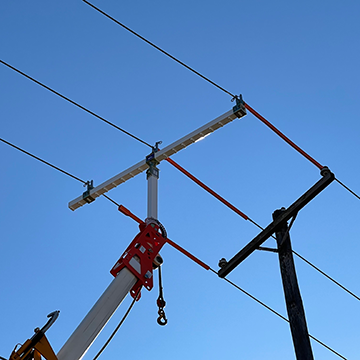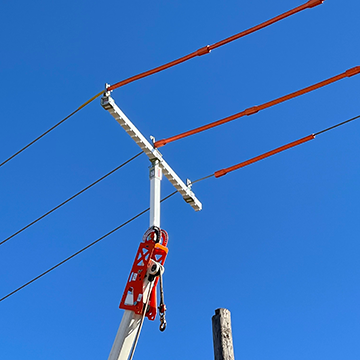City of Escanaba, Michigan, Electric Department finds a way to speed up a traditionally slow task.

Like many other electric utilities, the city of Escanaba, Michigan, Electric Department found the process of changing out poles to be terribly inefficient. A lot of time and effort seemed to be wasted for simply replacing a pole. But instead of figuratively “holding the line” and continuing to do things the same way, Escanaba’s linemen sought something better, discovering a new solution to speed up the job by literally holding the lines.
Located in Michigan’s upper peninsula, Escanaba’s electric utility serves approximately 7,200 customers. It employs 14 people, including nine linemen. Gerald Pirkola is the electric utility director overseeing the work to ensure reliable power supply to the city. He estimates his crews change out 50 to 90 poles each year, resulting in a significant investment of time and effort.
The electric poles in Escanaba are predominantly horizontal construction, running 7,200 volts line-to-ground and 12,470 volts phase-to-phase. When replacing poles in the past, crews would typically install the new pole as close as possible to the existing pole, transfer the energized lines and then remove the old pole.
Pirkola’s crew leader became convinced that there must be a faster, easier way to do the change-outs and began actively searching for alternatives. Eventually, he came across a Triple Line Lifter from LineWise, a brand of job-specific utility products. The Triple Line Lifter, which consists of a fiberglass mast and crossarm, is designed to support up to three energized phases when conducting pole maintenance. It seemed like an ideal solution for increasing the utility’s efficiency since it could be used to easily lift energized phases from a pole and hold them out of the way while the pole was being replaced. And instead of drilling for a new pole location, crews could simply re-use the existing hole.

The next step of the process involved meetings with LineWise representatives, who helped recommend a proper solution and ensured compatibility with the utility’s trucks. “They went above and beyond with their customer service,” said Pirkola.
While the Triple Line Lifter is available in various configurations for both transmission and distribution work up to 230kV, it was determined that the product best suited for Escanaba was the TLL-300D. Intended for distribution work below 34.5kV, this model is designed to mount on a digger derrick or crane. “We’re fortunate to have two digger derricks at our utility, so we can use one for the line lifter, while the other lifts the pole,” said Pirkola.
The TLL-300D attaches quickly and easily, allowing the linemen to get right to work. “It sets up in a matter of minutes,” said Pirkola. “There’s a bracket that mounts to the digger derrick boom, which we typically install in the shop. Then, when we get to the jobsite, it’s just a couple of pins that attach the mast and crossarm to the bracket.”
Once the mast and crossarm are installed, the linemen can adjust the wire holder spacing to line up with the phases. These adjustments can be easily made in the field since no tools are required. Gravity gates on the wire holders provide a simple, yet effective approach for securing and releasing the lines. “You can move the wire holders from multiple locations around the line lifter,” said Pirkola. “The guys really like that convenience.”

After the phases are secured and lifted, the crossarms of the TLL-300D can be rotated up to 15 degrees each direction. “Depending on where you locate the digger derrick, you need to be able to adjust the crossarm angle when you boom up,” said Pirkola. “That’s really easy to do with the line lifter.”
Although the vast majority of Escanaba’s electric poles are horizontal construction, the city does have some poles, mostly on right angles, that are vertical construction. Nonetheless, the TLL-300D is adaptable for these types of poles, too, by simply changing the configuration of the crossarms and wire holders.
After only a few uses of the TLL-300D, Pirkola became convinced that the new tool will make pole maintenance considerably quicker and easier for his linemen, and he anticipates using it an average of two to three times per month. “I’d say it reduces work time by 25 to 30 percent,” he said. “And it makes the job easier, which was another goal of ours, since we deal with some rather busy poles.”
Beyond typical pole maintenance, Pirkola anticipates the product will come in handy for storm damage and unexpected events. In fact, shortly after purchasing the unit, a vehicle struck an electric pole, and the line lifter was brought into action for the repair. “It saved a couple hours on that job alone,” he said.
The TLL-300D shines most in situations where a pole is connected to underground conduits that feed customer loads. “When you put a new pole two feet from the existing one, it’s challenging to swing all of those conduits over to the new pole,” said Pirkola. “It’s a lot of work and a lot more digging. Now, we can eliminate those steps since the line lifter allows us to put the new pole in the existing hole. On those kinds of jobs, it can save us up to 50 percent on labor.”
Not only has the new equipment proven itself to cut time on the job by as much as half, but it has also made life a lot easier for Pirkola’s linemen. Because of that, he feels the TLL-300D is a great way to work “wiser,” not harder. “It’s going to get used quite a bit,” he said. “I would recommend every utility to have something like this.”
Leave a Reply